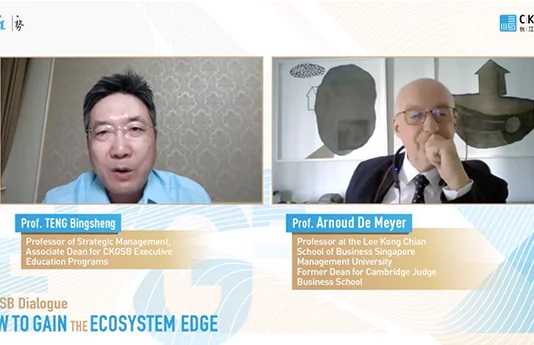Haier CEO Zhang Ruimin’s accomplishments in turning around a small almost-bankrupt refrigerator manufacturer into today’s home appliances giant are well-known and deserve enormous respect. He engineered a complete transformation on every dimension that matters: quality, logistics, customer focus and market-driven innovation. Building on these foundations, he also transformed Haier into a diversified home appliances company and by the late 1990s, had made it the dominant player in China.
Over the last 15 years, however, Haier appears to have stalled. Yes, it has grown and become much larger; by revenues, it is now the largest home appliance manufacturer in the world. However, this growth has come largely by riding the break-neck real estate—and, thus, appliances—boom in China. In my opinion, Haier’s success outside China remains a big question mark. After 20 years, it is but a niche player in the US and other developed markets. More worryingly, the distraction of pursuing developed markets has delayed Haier from focusing on where the real opportunities lie—emerging markets. Haier is struggling in both India and Latin America, markets that are now dominated by LG, Samsung and other players and would be very hard to crack.
Given the end of the property boom in China, Haier now faces a major conundrum. Unless the company can find other growth opportunities, it faces years of potentially very slow growth. It is in this context that one can understand why Zhang Ruimin has embarked on a new platform strategy.
According to the company’s website and media statements by Zhang, key elements of the platform strategy include:
(a) Moving from standard to customer-configured appliances
(b) Reorganizing Haier’s 60,000 employees into 2,000 self-operating units called zi zhu jing yi ti, or ZZJYT
(c) Making each ZZJYT customer-focused
(d) Flattening the hierarchy by giving each ZZJYT very high autonomy and control over R&D, marketing, sales and finance functions
(e) Leveraging the internet as a platform to enable each ZZJYT to connect with the customer, other units within the company, and external complementors
The move from standardized to customer-configured appliances is indeed timely. As Zhang has noted, in the internet era, every company must strive to eliminate the distance between the producer and the customer. This is exactly the strategy that Dell has pursued since 1984, Cisco since the late 1990s, and BMW over the last 10 years. However, as the experience of these companies tells us, in industries where scale and scope are critical, customer-configuration requires large, highly automated factories fitted out with flexible manufacturing systems—the exact opposite of breaking down the company into small autonomous operating units.
To the extent that the idea of a large number of autonomous ZZJYT units is an important plank of the new platform strategy, one should have serious concerns about the wisdom of such an approach. We raise four central questions about this new approach.
Is “platform” a valid term to represent what Haier is trying to do?
The term “platform” has been around for over 15 years and originated with technology companies such as Microsoft, Cisco, Google and Apple. Like a platform on a train station, a technology platform serves as the place for other companies to land and take off. Think of Apple’s operating system for the iPhone. There are over a million apps that use the iOS as a platform. The same goes for Google’s Android or Microsoft’s Windows. Other examples of platform companies are Airbnb and Uber. It is hard to see how Haier could be called (or become) a platform company. Like air or electricity, the internet is too ubiquitous to be called a platform.
Is the ZZJYT approach valid for a company such as Haier?
The answer would be a clear “No.” According to Haier’s website, its 60,000 or so employees are now organized into 2,000 self-operating ZZJYT units. That comes to an average of 30 people per ZZJYT (assuming that no one leaves). It is impossible to imagine how Haier’s R&D, manufacturing and supply chain operations could be broken up into such small units without destroying the primary bases of competitive advantage in the home appliances business. Haier’s business revolves around physical products rather than simple customized videogames over the internet.
Are scale and scope no longer important as sources of competitive advantage for Haier?
According to Haier’s website, “The prime mover in the age of information technology is not scale or scope. Rather it is the platform.” This is grossly untrue, whether for physical products or IT services. Look at any of the giants of information technology: Apple, Google, Microsoft, Facebook, Uber, Baidu, Tencent or Alibaba. The IT sector is particularly vulnerable to the “winner take all” syndrome. As the founder of LinkedIn noted in a recent op-ed, in the IT sector, companies that learn how to scale up faster than others will be the ones that dominate their markets. Google’s 80-20 rule starkly illustrates the criticality of both exploitation (which requires a top-down leveraging of scale and scope) and exploration (which requires bottom-up innovation). Any company that focuses on just one or the other is courting disaster.
What are the risks associated with the ZZJYT approach?
If the ZZJYT is more than a slogan, then it requires a fundamental reorganization of Haier as a company. With an average of 30 employees per ZZJYT, Haier will destroy what made it great in the first place: its R&D capabilities, its large factories, its vast logistics network, and its excellent after-sales service. As the CEO of a consistently innovative Fortune 500 company once said to me: “Cut your chains and you become free. Cut your roots and you die.” Yes, Haier must remain committed to perennial innovation. However, it must also be wise to differentiate between “chains” and “roots”.
Anil K. Gupta is the Michael Dingman Chair in Strategy, Globalization and Entrepreneurship at the Smith School of Business, The University of Maryland and a member of the World Economic Forum’s Global Agenda Council on Emerging Multinationals. He is the coauthor of The Silk Road Rediscovered, Getting China and India Right, and The Quest for Global Dominance.




















